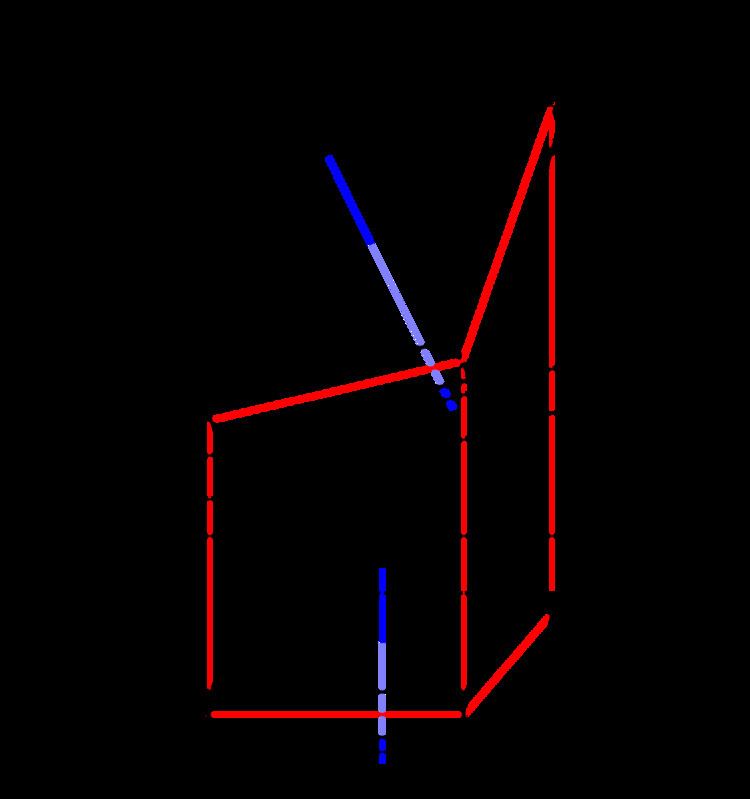 | ||
The Kirchhoff–Love theory of plates is a two-dimensional mathematical model that is used to determine the stresses and deformations in thin plates subjected to forces and moments. This theory is an extension of Euler-Bernoulli beam theory and was developed in 1888 by Love using assumptions proposed by Kirchhoff. The theory assumes that a mid-surface plane can be used to represent a three-dimensional plate in two-dimensional form.
Contents
- Assumed displacement field
- Quasistatic Kirchhoff Love plates
- Strain displacement relations
- Equilibrium equations
- Boundary conditions
- Constitutive relations
- Small strains and moderate rotations
- Isotropic quasistatic Kirchhoff Love plates
- Pure bending
- Bending under transverse load
- Cylindrical bending
- Dynamics of Kirchhoff Love plates
- Governing equations
- Isotropic plates
- References
The following kinematic assumptions that are made in this theory:
Assumed displacement field
Let the position vector of a point in the undeformed plate be
The vectors
Let the displacement of a point in the plate be
This displacement can be decomposed into a vector sum of the mid-surface displacement and an out-of-plane displacement
Note that the index
Then the Kirchhoff hypothesis implies that
If
Note that we can think of the expression for
Quasistatic Kirchhoff-Love plates
The original theory developed by Love was valid for infinitesimal strains and rotations. The theory was extended by von Kármán to situations where moderate rotations could be expected.
Strain-displacement relations
For the situation where the strains in the plate are infinitesimal and the rotations of the mid-surface normals are less than 10° the strain-displacement relations are
Using the kinematic assumptions we have
Therefore the only non-zero strains are in the in-plane directions.
Equilibrium equations
The equilibrium equations for the plate can be derived from the principle of virtual work. For a thin plate under a quasistatic transverse load
where the thickness of the plate is
where
Boundary conditions
The boundary conditions that are needed to solve the equilibrium equations of plate theory can be obtained from the boundary terms in the principle of virtual work. In the absence of external forces on the boundary, the boundary conditions are
Note that the quantity
Constitutive relations
The stress-strain relations for a linear elastic Kirchhoff plate are given by
Since
Then,
and
The extensional stiffnesses are the quantities
The bending stiffnesses (also called flexural rigidity) are the quantities
The Kirchhoff-Love constitutive assumptions lead to zero shear forces. As a result, the equilibrium equations for the plate have to be used to determine the shear forces in thin Kirchhoff-Love plates. For isotropic plates, these equations lead to
Alternatively, these shear forces can be expressed as
where
Small strains and moderate rotations
If the rotations of the normals to the mid-surface are in the range of 10
Then the kinematic assumptions of Kirchhoff-Love theory lead to the classical plate theory with von Kármán strains
This theory is nonlinear because of the quadratic terms in the strain-displacement relations.
If the strain-displacement relations take the von Karman form, the equilibrium equations can be expressed as
Isotropic quasistatic Kirchhoff-Love plates
For an isotropic and homogeneous plate, the stress-strain relations are
The moments corresponding to these stresses are
In expanded form,
where
At the top of the plate where
Pure bending
For an isotropic and homogeneous plate under pure bending, the governing equations reduce to
Here we have assumed that the in-plane displacements do not vary with
and in direct notation
The bending moments are given by
Bending under transverse load
If a distributed transverse load
In rectangular Cartesian coordinates, the governing equation is
and in cylindrical coordinates it takes the form
Solutions of this equation for various geometries and boundary conditions can be found in the article on bending of plates.
Cylindrical bending
Under certain loading conditions a flat plate can be bent into the shape of the surface of a cylinder. This type of bending is called cylindrical bending and represents the special situation where
and
and the governing equations become
Dynamics of Kirchhoff-Love plates
The dynamic theory of thin plates determines the propagation of waves in the plates, and the study of standing waves and vibration modes.
Governing equations
The governing equations for the dynamics of a Kirchhoff-Love plate are
where, for a plate with density
and
Solutions of these equations for some special cases can be found in the article on vibrations of plates. The figures below show some vibrational modes of a circular plate.
Isotropic plates
The governing equations simplify considerably for isotropic and homogeneous plates for which the in-plane deformations can be neglected. In that case we are left with one equation of the following form (in rectangular Cartesian coordinates):
where
In direct notation
For free vibrations, the governing equation becomes
